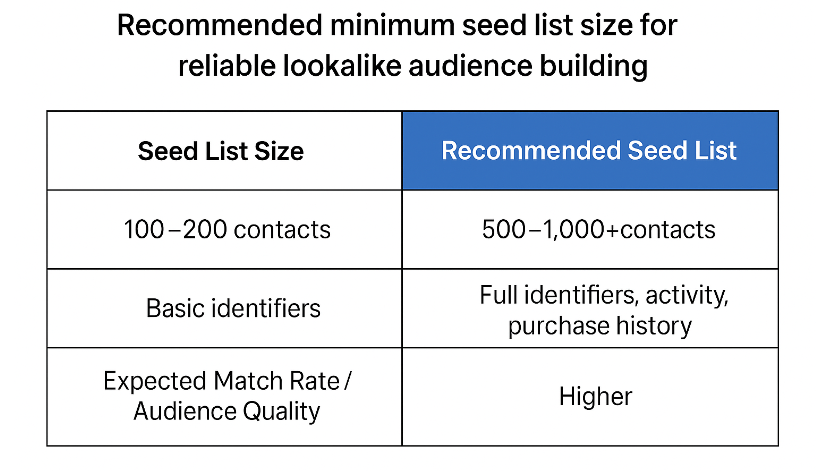Lookalike audiences work by analyzing patterns in your seed audience and finding people with similar behavior, interests, and demographics. The algorithm performs best when the seed audience has clear, consistent signals. A smaller but highly qualified seed dataset can outperform a seed list with thousands of mixed‑quality users.

Nearly 8 in 10 marketers saw improved conversions, and 68% experienced lower CPA after switching to lookalike-based targeting
A Meta study found that advertisers using refined seed lists saw up to 20–30% improvements in conversion rates compared to broad seed lists. The clearer your signals, the faster the algorithm identifies users with buying intent.
Ideal Seed Audience Size: How Small Is Too Small?
Many marketers assume that lookalike modeling requires massive datasets. In practice, 200–500 high‑value users can outperform thousands of average ones. Algorithms value signal strength, not list volume.
For example:
-
Lookalikes built from high‑intent purchasers show up to 2.5× higher ROAS than lookalikes built from newsletter subscribers.
-
A seed list consisting of top 1–5% paying customers often decreases CPA by 15–40% compared to using a broad customer set.
What Makes a High‑Quality Seed Audience?
To get the strongest results, your seed should represent the exact type of user you want the platform to find. Your best candidates usually include:
-
High‑frequency buyers
-
Customers with the highest lifetime value
-
Users who completed deep‑funnel actions (e.g., add to cart, purchase, subscription)
-
Engaged users with proven conversion intent
A consistent behavioral pattern across seed users helps the algorithm detect shared traits more effectively.
Segment Before You Seed
Instead of uploading a single broad list of “all customers,” segment your audience and test multiple seed groups based on different value tiers.
Popular segmentation approaches:
-
Top spenders — strongest correlation with future buyers
-
Repeat buyers — highly predictive of loyalty
-
Recent qualifiers — captures fresh behavioral signals

Recommended minimum seed list size for reliable lookalike audience building
Running parallel lookalikes from these segments reveals which group delivers the best cost‑per‑result.
Refresh Your Seed List Regularly
Behavior and markets evolve, and so should your lookalike seeds. Refreshing your seed data every 30–60 days helps maintain algorithm accuracy.
Brands that regularly refresh seed lists report:
-
Up to 18% lower CPA
-
Up to 25% higher conversion rates
-
More stable performance over long campaigns
Consistency matters: outdated seeds create weaker modeling and lower match quality.
Use Funnel‑Based Lookalikes for Stronger Performance
Different stages of your funnel require different types of seed audiences.
Examples:
-
Top of funnel: high‑value customers or top 1% buyers
-
Middle of funnel: add‑to‑cart users
-
Bottom of funnel: recent purchasers with high order value
Data from multiple advertisers show that using deep‑funnel seeds often improves purchase conversion rates by 20–45% compared to using generic “website visitors.”
Don’t Mix Intent Signals
Mixing low‑intent and high‑intent users in one seed audience dilutes algorithm quality. Keep your seed lists clean and focused.
Avoid combining:
-
Buyers + newsletter subscribers
-
Trial users + churned users
-
High‑value buyers + one‑time discount shoppers
A clean signal always produces a stronger lookalike.
Recommended Next Articles
If you want to continue improving your audience strategy, explore:

